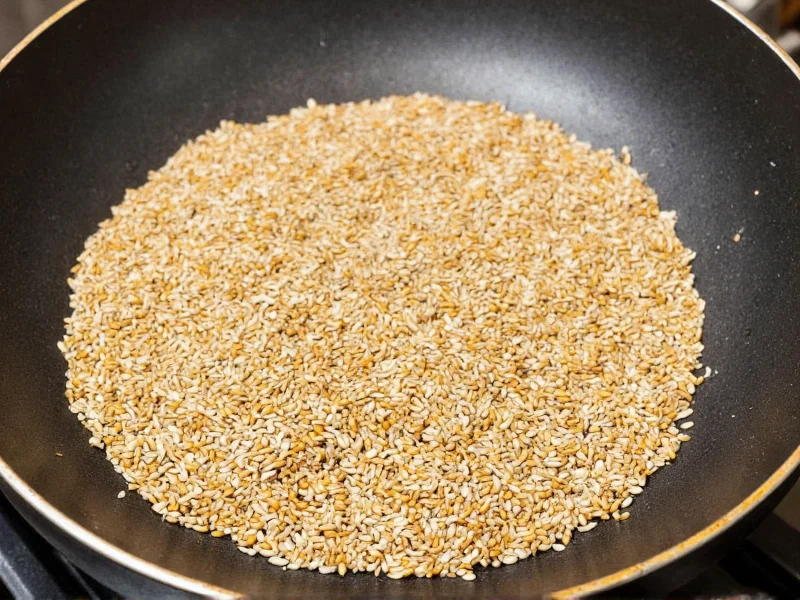Roasting sesame seeds unlocks their rich, nutty flavor and enhances their nutritional profile, making them perfect for garnishing dishes, adding to baked goods, or creating tahini. Whether you're preparing Asian cuisine, Middle Eastern dishes, or simply want to elevate your salads and stir-fries, properly roasted sesame seeds make a significant difference in flavor complexity.
Why Roast Sesame Seeds?
Raw sesame seeds have a mild flavor, but roasting transforms them through the Maillard reaction, developing complex nutty notes. The process also breaks down enzyme inhibitors, potentially improving digestibility. When you learn how to toast sesame seeds on stove or in oven, you gain control over the flavor profile for your culinary creations.
Two Effective Methods for Roasting Sesame Seeds
Professional chefs and home cooks agree that dry roasting (without oil) produces the purest flavor, though some prefer a light coating of oil for certain applications. Here are the two most reliable methods:
Stovetop Method (Best for Small Batches)
This traditional approach gives you maximum control over the roasting process, crucial since sesame seeds can go from perfectly toasted to burnt in seconds. Many cooks searching for how to roast sesame seeds prefer this method for its immediacy and visual control.
- Use a dry, heavy-bottomed skillet (cast iron or stainless steel works best)
- Add raw sesame seeds in a single layer (don't overcrowd)
- Heat over medium-low temperature (never high heat)
- Stir constantly with a wooden spoon or shake the pan frequently
- Watch for color change from pale beige to golden brown (3-5 minutes)
- Listen for a subtle popping sound as they roast
- Remove immediately from heat when fragrant and evenly colored
- Transfer to a cool plate to stop cooking process
Oven Method (Best for Larger Quantities)
When you need to roast larger amounts of sesame seeds, the oven provides more even heating. This approach is ideal for those asking how long to roast sesame seeds for meal prep or batch cooking.
- Preheat oven to 350°F (175°C)
- Spread seeds in a single layer on a rimmed baking sheet
- Bake for 5-10 minutes, stirring every 2-3 minutes
- Watch closely during the last few minutes
- Remove when seeds turn golden and emit a nutty aroma
- Transfer immediately to a cooling surface
| Method | Time Required | Best For | Key Advantage |
|---|---|---|---|
| Stovetop/Dry Pan | 3-5 minutes | Small batches (1-4 tbsp) | Maximum control and immediate visual feedback |
| Oven | 5-10 minutes | Larger quantities (1/4 cup+) | More even heating for bigger batches |
| Air Fryer | 4-6 minutes | Moderate quantities | Fast with good air circulation |
How to Tell When Sesame Seeds Are Perfectly Roasted
Mastering how to tell when sesame seeds are roasted comes down to three sensory indicators:
- Visual cue: Seeds change from pale beige to uniform golden brown (avoid dark brown which indicates burning)
- Aroma: A distinct nutty, toasted fragrance becomes noticeable
- Sound: Listen for a subtle popping or crackling sound as moisture escapes
When properly roasted, sesame seeds should have a crisp texture that shatters slightly when bitten. Over-roasted seeds develop a bitter taste that can ruin dishes, so err on the side of under-toasting if uncertain.
Avoiding Common Roasting Mistakes
Even experienced cooks make these errors when learning how to roast sesame seeds properly:
- Using high heat: Sesame seeds have high oil content and burn quickly. Always use medium-low heat.
- Not stirring constantly: Seeds at the bottom heat faster. Continuous movement ensures even roasting.
- Leaving seeds in hot pan: Residual heat will continue cooking them. Always transfer immediately to a cool surface.
- Roasting too large a batch: Overcrowding causes uneven cooking. Work in small batches.
- Not cooling completely: Warm seeds can become chewy from trapped moisture.
Storing Roasted Sesame Seeds Properly
Once you've mastered how to roast sesame seeds, proper storage maintains their freshness:
- Cool completely before storing (any residual warmth creates moisture)
- Store in an airtight container away from light and heat
- Room temperature: 1-2 months for optimal flavor
- Refrigerator: 3-6 months
- Freezer: 6-12 months (best for long-term storage)
For best results when using stored seeds, toast them briefly again to refresh the flavor before using in recipes. This simple step when learning how to store roasted sesame seeds properly ensures maximum flavor in your dishes.
Using Roasted Sesame Seeds in Cooking
Freshly roasted sesame seeds elevate countless dishes:
- As a garnish for Asian stir-fries and noodle dishes
- In homemade tahini (roasted seeds create darker, richer tahini)
- Added to breads, crackers, and baked goods
- As a crunchy topping for salads and roasted vegetables
- In marinades and spice rubs for meats and fish
- Mixed into homemade granola or energy bars
For those exploring how to toast sesame seeds for specific cuisines, note that Japanese cooking often uses white sesame seeds while Middle Eastern cuisine frequently features black sesame seeds, each with slightly different roasting characteristics.











 浙公网安备
33010002000092号
浙公网安备
33010002000092号 浙B2-20120091-4
浙B2-20120091-4